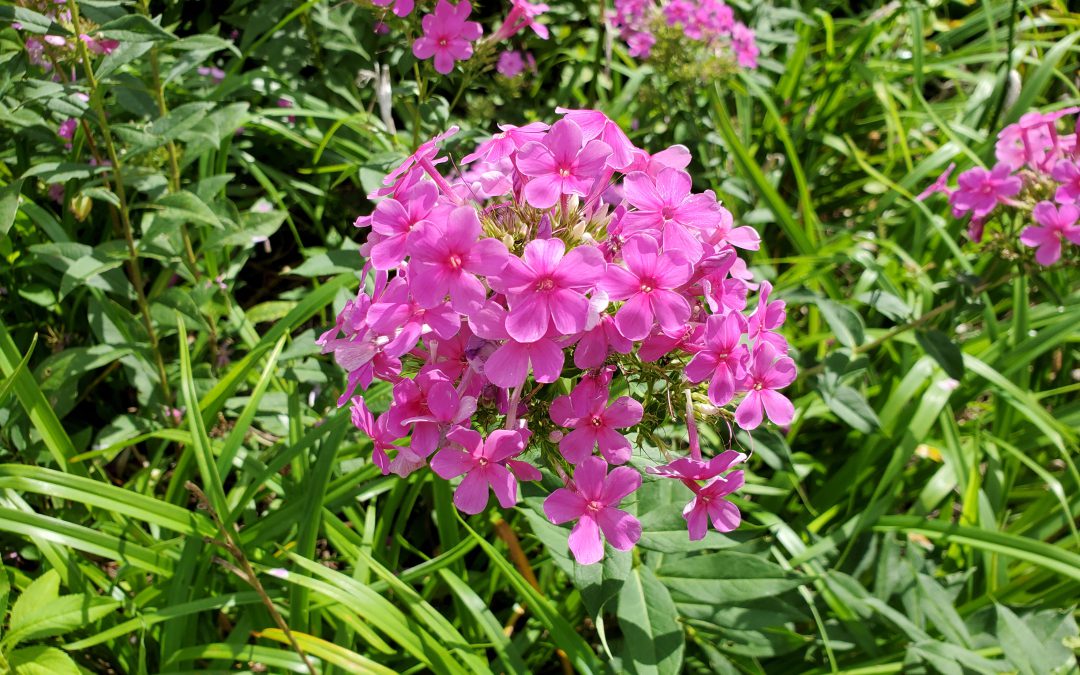
by Daniel J. Leonard | Aug 5, 2021
The number one request all would-be gardeners and budding landscape enthusiasts have is “I want something that I don’t have to take care of, tolerates the heat, blooms, and comes back every year”. That is a tall order in our climate but not an impossible one, especially if one is willing to take a step back in time and consider an old Southern passalong plant, Garden Phlox (Phlox paniculata)!

Garden Phlox (Phlox paniculata) in a Calhoun County landscape. Photo courtesy of Daniel Leonard.
This old heirloom perennial is an outstanding ornamental for Panhandle landscapes. Every spring, Garden Phlox emerges from a long winter sleep and shoots its attractive bright green foliage straight up, reaching 3-5’ in height. After hiding inconspicuously in the landscape all spring, Phlox then blasts into fiery magenta bloom during the heat of summer, beginning the show in late June. While individual Phlox flowers are only 1” wide or so, they are held prominently above the plant’s foliage in large clusters up to 8” in diameter and are about as eye-catching as flowers come. The flower show continues through July and August until finally fading out as fall rolls around. Plants then set seed and ready themselves for winter dormancy, repeating the cycle the following spring. A bonus, though individual Phlox plantings start off as small, solitary clumps, they slowly expand over the years, never over-aggressively or unwanted, into a mass of color that becomes the focal point of any landscape they occupy!
In addition to being gorgeous, Phlox is adaptable and demands very little from gardeners. The species prefers to be sited in full, blazing sun but can also handle partial shade. Just remember, the more shade Phlox is in, the fewer flowers it will produce. Site accordingly. Phlox is also extremely drought tolerant, thriving in most any semi-fertile well-drained soil. Though it can handle drought like a champ, Phlox will languish if planted in a frequently damp location. If water stands on the planting site for more than an hour or so after a big rain event, it is most likely too wet for Phlox to thrive. Once established, Phlox is not a heavy feeder either. A light application of a general-purpose fertilizer after spring emergence from winter dormancy will sustain the plants’ growth and flowering all summer long!
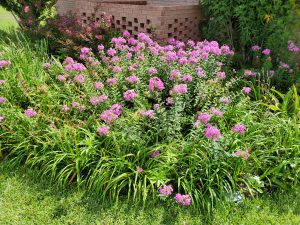
Clump of Garden Phlox in a Calhoun County landscape. Photo courtesy of Daniel Leonard.
Though the ornamental and low-maintenance attributes of plain Garden Phlox make it sound like a perfect landscape plant, it is uncommon in the modern nursery trade, having fallen out of favor as many old plants often do. The species is still a familiar site around old home places, cemeteries, abandoned buildings, and the like throughout the South, but is difficult to find in most commercial nurseries. The primary reason for this is that the commercially available modern Phlox hybrids sporting exotic flower colors and shapes are not tolerant of our growing conditions. These new Garden Phlox hybrids were bred to perform in the milder conditions of more norther climes and are extremely susceptible to the many fungal diseases brought on by Florida’s heat and humidity of summer, particularly Powdery Mildew. It’s best to avoid these newcomers and stick to the old variety with its pink flowers and ironclad constitution. Plain old Garden Phlox can be found in some independent and native plant nurseries, but the best and most rewarding method of acquisition is to make friends with someone that already has a clump and dig up a piece of theirs!
If you have been looking for a low-maintenance, high impact perennial to add to your landscape, old-fashioned Garden Phlox might be just the plant for you! For more information on Garden Phlox, other landscape perennials, passalong plants or any other horticultural topic, contact your local UF/IFAS County Extension Office. Happy Gardening!

by Larry Williams | Jul 15, 2021
Q. One of my two fig trees has produced a few figs. The other one, which is the largest and healthiest tree, has never had a fig on it. Both where planted six years ago. Why is it not producing?
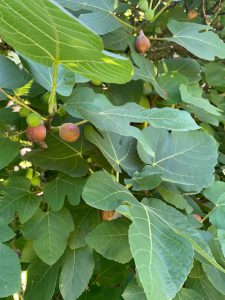
Mature fig tree with fruit. Photo credit: Larry Williams
A. It may be a matter of age and being overly vigorous. When a fruit tree is younger, it puts most of its energy into producing leaves and shoots. Until the plant becomes mature and slows down in the production of leaves and shoots, it will produce few to no fruit. It may take a year or two more for your tree to slowly and gradually switch from producing mostly leaves and shoots to producing and maturing some fruit. Patience is needed.
Be careful to not overdo it in fertilizing and/or pruning your fig tree. Too much fertilizer, especially nitrogen, or severely pruning the tree will result in the tree becoming overly vigorous at the expense of setting and maturing fruit. This includes fertilizer that the tree may pull up from a nearby lawn area. A tree’s roots will grow outward two to three times beyond its branch spread into adjacent lawn areas.
The end result of being heavy handed with fertilizing and/or overdoing it in pruning is the same – it forces the plant to become overly vigorous in producing leaves and shoots at the expense of producing and maturing fruit.
In addition, the following is taken from an Extension publication on figs and includes the most common reasons for lack of fruiting, in order of importance.
- Young, vigorous plants and over-fertilized plants will often produce fruit that drops off before maturing. If plants are excessively vigorous, stop fertilizing them. Quite often, three of four years may pass before the plant matures a crop because figs have a long juvenile period before producing edible quality fruit.
- Dry, hot periods that occur before ripening can cause poor fruit quality. If this is the case, mulching and supplemental watering during dry spells will reduce the problem.
- The variety Celeste will often drop fruit prematurely in hot weather regardless of the quality of plant care. However, it is still a good variety to grow.
- An infestation of root-knot nematodes can intensify the problem when conditions are as described in item 2.
- You could have a fig tree that requires cross-pollination by a special wasp. This is a rare problem. If this is the case, then it will never set a good crop. The best way to resolve this is to replace the plant with a rooted shoot of a neighbor’s plant you know produces a good crop each year.
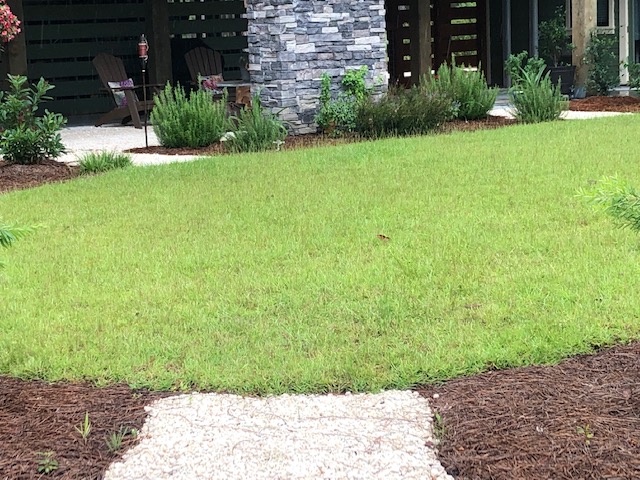
by Stephen Greer | Jul 1, 2021
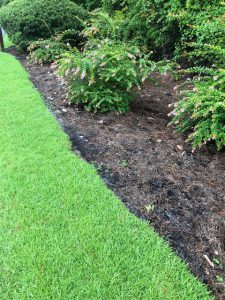
Photo Courtesy: Stephen Greer
Lawn areas come in all sizes and shapes. Some are large open expanses providing long views and others are smaller versions surrounded by shrubs and trees creating a more private and secluded setting. There are a number of reasons for reducing the size of a lawn with some coming into play with your decisions. A home lawn is often an important part of the landscape that provides a place to play outdoors from picnicking, tossing the ball to taking a quite stroll.
Maintaining a healthy lawn is important to an overall performance of this part of the landscape. Several factors are involved in the success in keeping a strong and resilient lawn. Understanding the needs of a grass to remain healthy involve soil testing to address soil pH and nutrient needs plus water challenges. Misuse of fertilizer and over irrigation can be costly to you and to the overall health of the lawn. These decisions can lead to reducing lawn size to managing cost or removing underused areas.
There are big benefits to reducing your lawn from saving time in mowing, trimming and other manicuring needs to saving energy costs involving the lawn mower not to mention reducing pollution from the mower or weed eater. The reduced amounts of pesticides needed to manage weeds and disease to the lawn saves time and money.
Another way to look at the reducing the size of our lawn is there will be more space for expanding plant beds and potential tree placement. These settings increase the opportunities for a more biodiverse landscape providing shelter, protection and food options for birds and other wildlife.
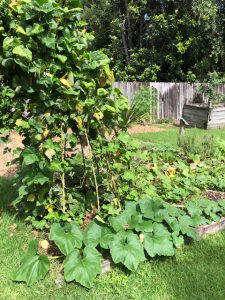
Photo Courtesy: Stephen Greer
The lawn can serve as a transition space that leads from one garden room space to another, while still offering a location to bring the lawn chair out to enjoy all that is around your lawn. Lawns and the landscape are ever changing spaces, especially as your trees and shrubs grow and mature to sizes that can directly impact the lawn performance. Often levels of shade will diminish edges and other areas of the lawn. This often will define the reduction of the lawn size moving going forward. Just remember that lawns and landscapes occupy a three-dimensional space involving the horizontal, vertical and overhead spaces. Just look around and think about what is best for you, your family and the setting.Are you more interested in developing other parts of the landscape? With many of us spending more time at home over the last year plus it gave time to think about the outdoor areas. Growing our own vegetables may be a new or expanding part of the landscape with the use of raised beds or interplanting into the existing landscape. Gardening can assist in reducing stress while at the same time providing that fresh tomato, lettuce, herbs and other fun healthy produce.
What ever your decisions are enjoy the lawn and landscape. For additional information, contact your local University of Florida IFAS Extension office located in your county.
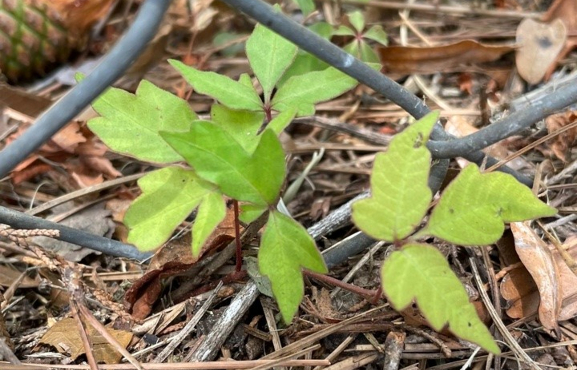
by Pat Williams | Jul 1, 2021
We work very hard to maintain our gardens and then we look up and vines are growing 20′ into the trees. I get asked frequently “what is growing up my trees?” My first answer is “probably the same things growing on your fences.” These include Smilax species, commonly called catbrier or greenbrier, Vitis rotundifolia, referred to as wild muscadine grape, Parthenocissus quinquefolia or Virginia Creeper, and the one to be most careful with, Toxicodendron radicans, known by many as Poison Ivy.
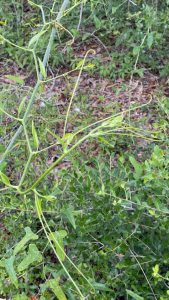
Spring growth on the Smilax vine.
Smilax is a native vine that grows quickly in spring and all summer. There are 12 species in Florida and 9 species commonly found in the Panhandle. Besides being armed with thorns on their stems and some leaves, Smilax spreads by underground stems called rhizomes. If you choose to ignore it, some species can cover your trees and the stems become woody and hard to remove. This vine also produces fruit and seeds are dispersed by birds all while the underground rhizomes are spreading under your lawns and gardens.
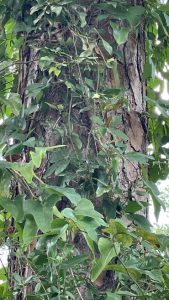
Smilax can quickly cover a tree trunk.
Removal can be difficult and mowing the vines only encourages more growth. When trying to remove by hand, wear heavy leather gloves and some eye protection because of the thorns. Cut the stems about three feet above the ground which allows you some stem to pull on to bring it out of your tree. You also then have a handle to pull and try to remove some of the rhizome from underground. Digging rhizomes is time consuming, but gives you piece of mind that they won’t come back immediately. Our family actually harvests the new shoots in spring and we use them like asparagus.
Wild muscadine grape is also native and difficult to remove. Most of the vines in nature are male and only produce by runners along the ground and then grow upwards. The female vine can produce 4-10 grapes in a cluster and then reseeds itself.
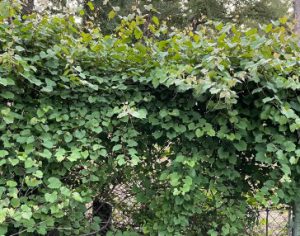
Wild muscadine grape covering a fence.
Wild grape completely covers plants and eventually the plants underneath can die. There are no thorns to contend with when removing wild grape, it is just time consuming, especially if it has taken over your fence or natural areas.
Virginia Creeper is a native vine, still considered a nursery plant in some areas of the country, and has bright red fall color.
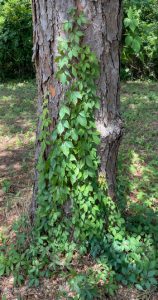
Virginia Creeper climbing a tree trunk.
It is most often confused with poison ivy because of having five leaflets per leaf whereas poison ivy only has three leaflets per leaf. It spreads by seeds, runs along the ground, and is the easiest of these four vines to remove from your property.
Poison Ivy is a native vine distinguished by its three leaflets with the individual leaflets getting up to 6″ long. This vine spreads by seeds and underground rhizomes. What makes removal of this vine difficult is the urushiol oils which causes the skin rashes and blistering.
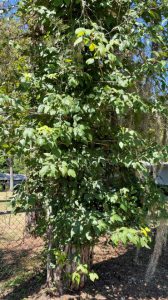
Poison ivy covering a tree trunk.
Care must be taken to cover up all skin and I recommend wearing waterproof clothes versus cotton which can absorb the oils and transfer them to your skin. Under no circumstances should these vines be put on the burn pile, the oils can become airborne and then you can inhale them.
Here are a few helpful tips when battling these native vines. First have patience and be dedicated, this removal will not happen over night. It may take a year or two to rid your property of the original vines. Be diligent though, because birds will continually land in your trees and deposit more seeds to get a fresh start. Try to remove vines when they are young and just beginning to climb your trees and fences. If you know you don’t have the time or energy to remove the vines from all your trees, at least cut the vines close to the ground to reduce flowering and new seeds. Be careful with poison ivy because falling leaves still contain oils. Once the vines start to have a new flush of growth, spray a non-selective herbicide on new growth and you should have good results. Lastly, remember one person can make a difference in trying to reduce the number of nuisance vines in our communities.
Here are some sited references to help with your removal tasks. Key to Nine Common Smilax Species of Florida. https://edis.ifas.ufl.edu/publication/fr375. Smilax is a Vine that can be Difficult to Control. http://blogs.ifas.ufl.edu/wakullaco/2017/04/21/smilax-is-a-vine-that-can-be-difficult-to-control/. The Muscadine Grape (Vitus rotundifolia Michx.) https://edis.ifas.ufl.edu/publication/hs100. Muscadine Grape Vines: Difficult to Control in Your Landscape. http://blogs.ifas.ufl.edu/wakullaco/2017/03/24/muscadine-grape-vines-difficult-to-control-in-your-landscape/. Parthenocissus quinquefolia: Virginia Creeper https://edis.ifas.ufl.edu/publication/fp454. Identification of Poison Ivy, Poison Oak, Poison Sumac, and Poisonwood. https://edis.ifas.ufl.edu/publication/EP220.
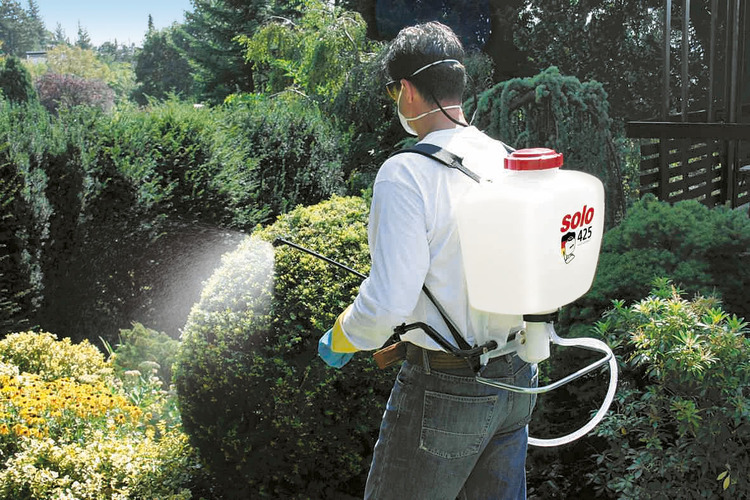
by Daniel J. Leonard | Jun 24, 2021
Nutsedge, commonly called “nutgrass”, is one of the most important and difficult to control weed pests in the world. Found in nearly every growing situation, from crop fields and vegetable gardens to landscapes and turfgrass lawns, I bet every person reading this has contended with controlling nutsedge at some point! Nutsedge (a common term to describe several species of weeds in the genus Cyperus) not only reduces curb appeal, but also h as a detrimental effect on desirable plantings around it. Because of its aggressive nature and dense root system, it competes heavily with “good” plants for water, light, and nutrients, causing the plants we are trying to grow to suffer. This is a weed that you definitely do not want in your lawn or landscape!
To keep nutsedge at bay, it’s important to know a few facts about it. First, “nutgrass” is not a grass at all, but a totally different class of plants known as sedges. This is important because selective herbicides used to kill grassy weeds will not affect nutsedge. Though they’re grass look-alikes, sedges can be distinguished by their distinctive triangular shaped stems. You can actually feel the three edges of nutsedge stems. If ever in doubt over whether a weed is a grass or a sedge, remember “sedges have edges”. Most sedges are perennials, dying back to the ground each year in winter and reemerging from tubers, called “nutlets”, that can survive over a foot under the ground! Also, while sedges generally prefer wet areas, they aren’t very particular about where they grow and are equally at home in sand or clay, wet or dry, and sun or shade. All these characteristics make sedges hard to control and cause much consternation amongst gardeners!
The first line of defense in controlling nutsedge is keeping a dense cover over any bare ground. In lawns, this means maintaining a thick, healthy turf as weeds love to enter lawns through thin or patchy areas. This can be accomplished by mowing regularly, fertilizing appropriately based on a soil test, not overirrigating while also not allowing the grass to suffer badly during droughty periods. Easier said than done. In landscape beds, preventative control is a little easier. First, as nutsedge prefers wet areas, only irrigate when it is needed. During much of the year, most established landscapes can get by on rainfall alone. Next, simply maintain a roughly 3” layer of pine straw, wood chips, pine bark, or other natural mulch of your choice. Doing so will reduce all manner of weeds, nutsedge included, and is generally beneficial for ornamental plants as well! I do not recommend landscape fabric as it is a pain to install and remove and is not extremely effective at reducing nutsedge as the sedge’s sharp growing points punch right through most plastic or fabric mulches.
Though mulching and other preventative measures can reduce nutsedge numbers, those methods alone are usually not enough and chemical herbicides are required. Fortunately, in Panhandle lawns and landscapes, there are several excellent, readily available options for sedge control: imazaquin and halosulfuron.
- Imazaquin is the active ingredient in the common product Image Kills Nutsedge and has good activity on most sedge species. It can be applied safely to all the common turfgrass species grown in the area and can even be sprayed right over the top of most common ornamental landscape plants!
- Halosulfuron is the active ingredient in the product Sedgehammer (available online or at specialty landscape supply stores) and several other generic products. Halosulfuron products provide excellent control of all nutsedge species and are safe to use in all turfgrass species found in Florida. While most landscape plants are tolerant of halosulfuron application, use care and try to only spray it on sedge weeds to avoid any unwanted yellowing or damage.
While both products begin working immediately, it may take several weeks to see sedge weeds start suffering and patience is necessary! Though both products are effective, follow up applications 3-4 weeks later are generally necessary to clean up any surviving sedge.
Nutsedge is a nasty little weed that can be difficult, though not impossible to manage. Through some smart cultural practices and timely applications of either imazaquin or halosulfuron, you can keep your lawn and landscapes nutsedge free! For more information about nutsedge control on your property or any other agricultural or horticultural topic, contact your local UF/IFAS County Extension office! Happy Gardening!















